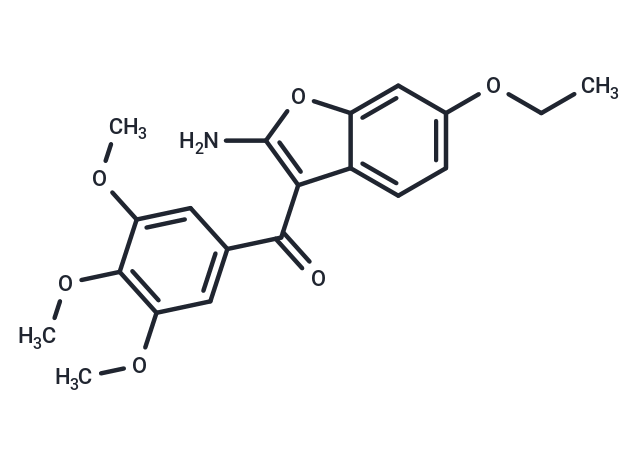Shopping Cart
Remove All Your shopping cart is currently empty
Your shopping cart is currently empty
Tubulin polymerization-IN-13 (Compound 4f) is a potent tubulin polymerization inhibitor with an IC50 of 0.37 μM, demonstrating significant anti-proliferative effects on cancer cells, inducing apoptosis, and exhibiting potential antivascular activity [1].

| Pack Size | Price | USA Warehouse | Global Warehouse | Quantity |
|---|---|---|---|---|
| 25 mg | $1,520 | 6-8 weeks | 6-8 weeks | |
| 50 mg | $1,980 | 6-8 weeks | 6-8 weeks | |
| 100 mg | $2,500 | 6-8 weeks | 6-8 weeks |
| Description | Tubulin polymerization-IN-13 (Compound 4f) is a potent tubulin polymerization inhibitor with an IC50 of 0.37 μM, demonstrating significant anti-proliferative effects on cancer cells, inducing apoptosis, and exhibiting potential antivascular activity [1]. |
| In vitro | Tubulin Polymerization-IN-13, at concentrations ranging from 0.005 to 2.8 nM, effectively inhibits the proliferation of tumor cells, while exhibiting non-toxic effects on non-tumor cells at concentrations between 8.7 and 10 μM. Furthermore, treatment with Tubulin Polymerization-IN-13 at doses of 1 to 50 nM for 24 hours leads to cell cycle arrest at the G2/M phase, and a concentration of 10 nM induces apoptosis within 24 and 48 hours of treatment. This compound also causes alterations in the microtubule network at doses between 10 and 100 nM after 24 hours of exposure. In depth analysis reveals IC50 values of 2.8 nM, 2.1 nM, 0.005 nM, 2.7 nM, 0.31 nM, and 0.28 nM for the cell lines HeLa, HT-29, Daoy, HL-60, SEM, and Jurkat, respectively, indicating its efficacy in halting cell proliferation. Additionally, the compound has shown a GI50 of 8.7 μM in quiescent lymphocytes, demonstrating its safety in non-cancerous cells. Detailed cell cycle, apoptosis, and immunofluorescence analyses on HeLa cells underline Tubulin Polymerization-IN-13's mechanism of action, which includes G2/M arrest, activation of caspase-9, cleavage of PARP, phosphorylation of Bcl-2, downregulation of Mcl-1, and disorganization of microtubules, further establishing its potential therapeutic benefits. |
| In vivo | Tubulin polymerization-IN-13, administered through intraperitoneal injection at doses of 15 or 5 mg/kg once every other day for a total of four administrations, significantly diminished tumor growth in a dose-dependent manner within an orthotopic murine model of mammary carcinoma (E0771 cell line) implanted in seven-week-old female C57BL/6 mice. The treatment resulted in a 45.7% reduction in tumor mass at 15 mg/kg and a 16.9% reduction at 5 mg/kg, without any observed toxicity or decrease in body weight of the animals [1]. |
| Molecular Weight | 371.38 |
| Formula | C20H21NO6 |
| Cas No. | 2426665-56-5 |
| Smiles | C(=O)(C=1C=2C(OC1N)=CC(OCC)=CC2)C3=CC(OC)=C(OC)C(OC)=C3 |
| Storage | Powder: -20°C for 3 years | In solvent: -80°C for 1 year | Shipping with blue ice/Shipping at ambient temperature. |
| Size | Quantity | Unit Price | Amount | Operation |
|---|

Copyright © 2015-2026 TargetMol Chemicals Inc. All Rights Reserved.